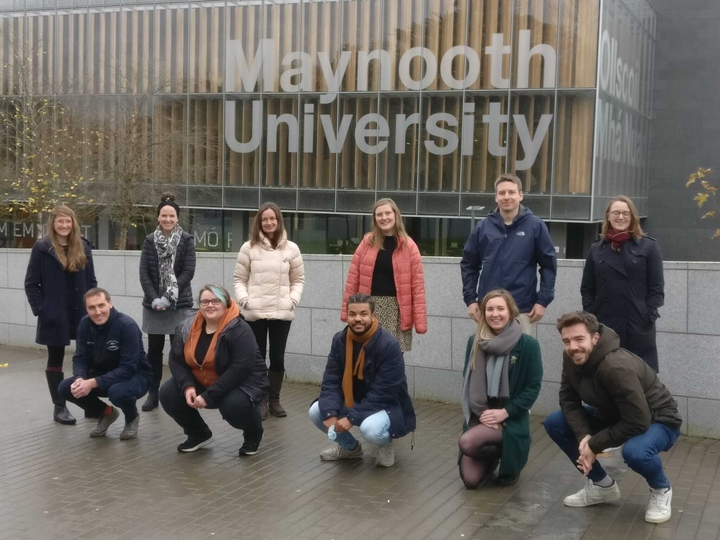The A4 annual meeting took place today!
 Image credit: Gerard McCarthy & Corinne Voces
Image credit: Gerard McCarthy & Corinne Voces
Today (Nov 18, 2021), the A4 team hosted the A4 annual meeting and presented some of their latest research material. In the past year, our team has grown bigger and is now more than ever a very exciting environment to work in. Not everyone is there on this picture, but there is (from left to right): Levke Caesar (WP1), Niamh Cahill (WP2), Samantha Hallam (ROADMAP), Maeve Upton (WP2), André Düsterhus (WP2), Emma Worthington (NOC) (top row), Gerard McCarthy (WP1), Catherine O’Beirne (WP2), me (WP1), Zoe Roseby (WP3), Fermin Alvarez (WP3) (bottom row).
A4 (Aigéin, Aeráid, agus athrú Atlantaigh) is a project led by Gerard McCarthy which looks at Atlantic change, sea level, and decadal climate prediction. It is a project which gathers scientists from different research institute: the Irish Climate Analysis and Research UnitS (ICARUS, Geography Dpt, Maynooth University), the Hamilton Institute (Maynooth University), and Trinity College Dublin (TCD). Most of us are part of ICARUS, and we effectively make up the oceanography section of this institute.
Looking forward to the @a_ceathair annual meeting today. We've had to move everything online so send a message if you'd like to join and I'll forward the link. pic.twitter.com/yZC4jk5OG4
— A4: Aigéin, Aeráid, & athrú Atlantaigh (@a_ceathair) November 18, 2021
The first work package (WP1), which I am part of, focuses on the large scale Atlantic variability (currents, heat transport, heat exchanges, etc.). This work package is led by Gerard McCarthy, while Levke Caesar and I complete the team. We work in strong connection with ROADMAP member Samantha Hallam, and PhD workers Emma Worthington (National Oceanography Centre Southampton) and Jamie Matthews (Imperial College London). We study the variability of the Gulf Stream, of the Atlantic Meridional Overturning Circulation (AMOC), and more broadly of the currents that make up the North Atlantic. Gerard and I also study the sea-level variability, and we are particularly interested in coastal areas, where sea-level changes are of upmost importance to humankind. Levke and Gerard have a long-standing interest for the AMOC.
The second package (WP2) is led by André Düsterhus and focuses on seasonal to decadal prediction (forecast, but on long timescales). Their work is made using statistical methods of prediction, and the outcomes of their research is quite diverse. For example, they try to create better prediction of the North Atlantic Oscillation and/or of others important proxies for Ireland weather using sea surface information (temperatures, in particular). They also work on forecasting fish population displacement around Ireland. A part of the team is also strongly focusing on statistical models of geological tide gauges, in link with work package 3.
The work package 3 (WP3), led by Robin Edwards, is mainly based in Trinity College Dublin and strongly function in connection with the two other work packages. Their efforts focus on reconstructing paleo sea-level variations using geological tide gauges. This is a technique which uses core sampling of salt marsh mud. Water levels are estimated based on the absence/presence of high-marsh/low-marsh species in the sample.
This meeting was an opportunity for me to spend a week in Ireland (I returned to France earlier this year due to the COVID19 outbreak which has forced us to solely work remotely). I was hence able to meet some new colleagues which I had only seen during video meetings. I had two very productive days with Samantha Hallam, working on tide gauge data. I was also able to spend some time with André Düsterhus and Levke Caesar, two colleagues that share my office in Eolas Building, North Campus, Maynooth University. Sadly, the Irish government has now announced that University should return to a strict working from home policy, in the hope to maintain COVID case numbers low. This occurs only two months after allowance to return to the office was announced. This does mean that my stay in France will continue, for now.